Art & Exhibitions
Christo and Jeanne-Claude’s Works in Progress Get Center Stage at Galerie Gmurzynska
The glamorous opening took place on Valentine’s Day.
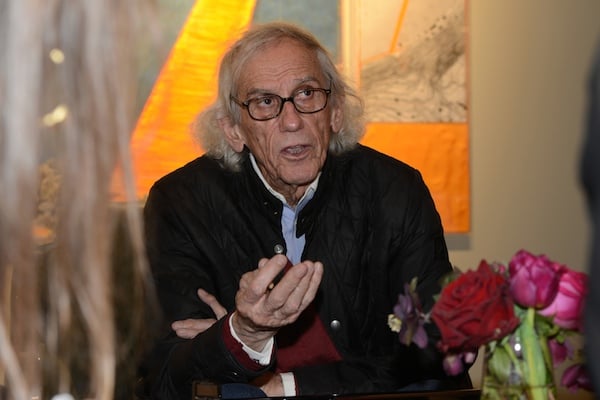
Photo: courtesy Galerie Gmurzynska
The glamorous opening took place on Valentine’s Day.

Amah-Rose Abrams

It’s hard not to be overwhelmed by the majesty of nature when driving through the Alps across the Swiss-Italian border, and could there be a better introduction to the works of Christo Vladimirov Javacheff and his late wife Jeanne-Claude?
A self-proclaimed environmental artist—by lack of a better definition—Christo is currently in the process of realizing three works across the world: Mastaba (1977-), in Abu Dhabi in the United Arab Emirates; Over the River (1992-), in Colorado in the United Sates; and Floating Piers (2014-2016), which will be realized on June 18 at Lake Iseo in Northern Italy.
The exhibition “Christo and Jeanne-Claude: Works in Progress,” curated by Germano Celant, opened on Sunday February 14 at Galerie Gmurzynska in St. Moritz, featuring works stemming from all three projects, examining the sites, as well as the ideas and actual realization of each of these epic projects.
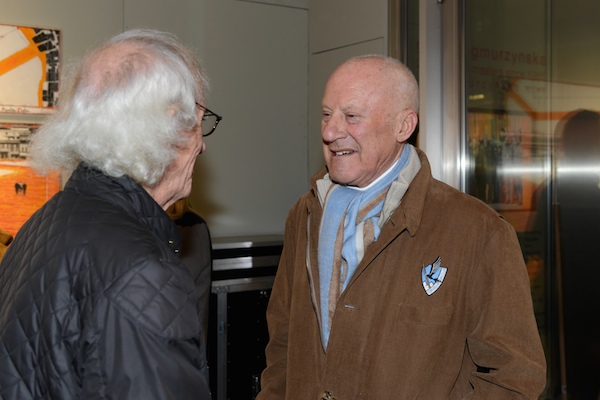
Christo and Sir Norman Foster at Galerie Gmurzynska St. Moritz.
Photo: Courtesy Galerie Gmurzynska.
The glamorous, affluent Swiss ski-town of St. Moritz is home to a few major galleries and this exhibition, opening on St. Valentine’s Day at the height of ski season, is both a romantic gesture for Christo—as his wife and creative partner, who sadly passed away in 2009, co-conceived the works on show—and a smart move on behalf of the gallery. The star studded opening in the Alps was attended by Sir Norman Foster and the actor George Hamilton, as well as Christo himself.
“Jeanne-Claude and myself started these projects together and of course now finally the projects will be realized,” Christo told artnet News at the glamorous opening party. “I miss her all the time but the same way … This is something true. I feel as though she is doing it with me.”

Christo and Jeanne-Claude looking for a possible site for The Mastaba (1982).
Photo: Courtesy Galerie Gmurzynska © Christo.
Over the course of 50 years, Christo and Jeanne-Claude have realized 22 out of 69 works. That may not sound like very many but if you consider the scale, preparation, and cost involved in each of their environmental works it becomes a staggering achievement.
Often called a “wrap artist,” Christo is known for his large-scale works with fabric. Over the course of their career, he and Jeanne-Claude wrapped islands, coastlines, trees, and even the Reichstag in Berlin in 1995. Made purely for the sake of art, their works are temporary and at the complete mercy of the elements, set to disappear without trace. The concept of these works, which are entirely self-funded, is that they have no purpose and cannot be bought or commissioned.
It is for these reasons that Christo’s works on paper are highly prized. These intricate maps, drawings, and calculations—incorporating the specifically dyed fabrics he develops for each project—measure up to about 2 meters at their largest and in no way are lessened by comparison to the installations that come later in the process.
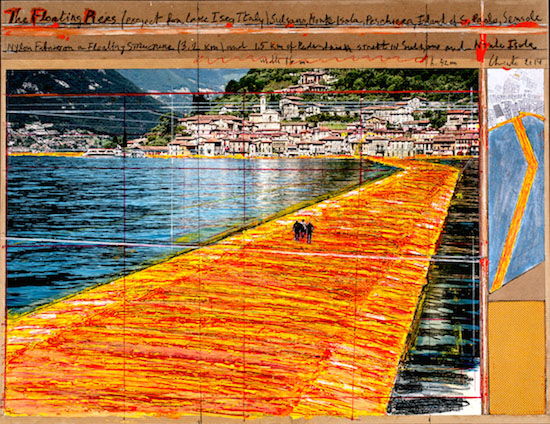
Christo, The Floating Piers (2014).
Photo: Courtesy Galerie Gmurzynska.
The three projects detailed in these works on paper range from the realized and the ambitious to the near impossible. For example, Floating Piers has been in its conceptual stage since the early 1970s, and was shelved after failing to get permission in both the Rio de la Plata in Argentina and Tokyo Bay.
“After the wrapping of the Reichstag in 1995 we were so excited to do a project where we walked on the water,” Christo told artnet News. “We started working on Floating Piers again.”
The project comprises 220,000 weighted floating cubes wrapped in fabric that will create a walkway between the Monte Isola island in the Lake Iseo and the mainland. This means the 2,000 residents, who have never had a connecting bridge, will essentially be able to walk on water over a floating walkway which will stretch 1.5 kilometers.
“[My projects] are not impossible things, they are technically very simple, they are not electronic, they are very manual, but that’s where the difficulties lie,” Christo said of his ambitious work. “The biggest part is to put people together because this project is done with a huge group, from lawyers to engineers and fabricators. Even after all this is installed, we need 600 non-skilled workers to install the fabric.”
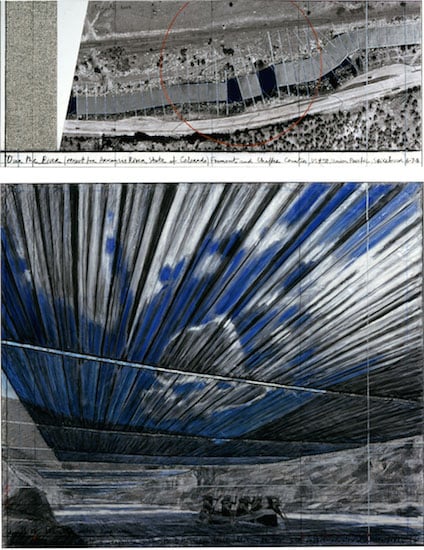
Christo, Over the River (2008).
Photo: Courtesy of Galerie Gmurzynska.
Over The River is currently on the cusp of being given permission to be realized in the Arkansas River, as the Obama administration is battling with local authorities in an effort to make the project happen. If it does, in summer 2017 rowers will be able to raft through the rapids, underneath the swathes of fabric. These drawings give a striking impression of what the realized work would look and feel like, showing the scale of the work through aerial drawings and annotated photographs, with samples of the iridescent fabric.
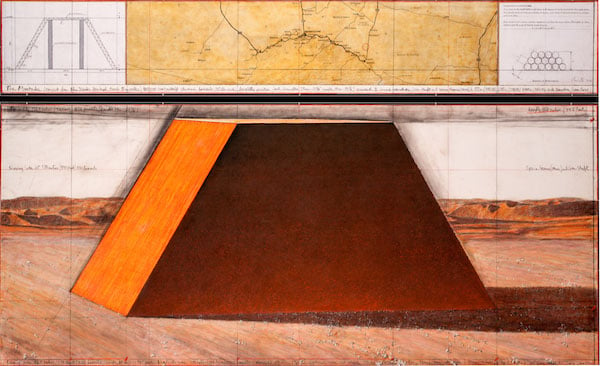
Christo, The Mastaba.
Photo: Courtesy Galerie Gmurzynska.
At 150 meters high, 300 meters wide, and 225 meters deep, if realized, the Mastaba would be the largest sculpture in the world, made of 410,000 multi-colored oil barrels. It would also be Christo and Jeanne-Claude’s only lasting work. The works on paper concerning this project bring the giant scale of the project to the fore, as tiny sketched figures at the base of the work barely register as human in comparison.
There is something extremely moving about the idea of this permanent monument to a career of building ephemeral, environmental works, made of the waste of the world’s self-destruction through oil. One can only hope that Christo’s astonishing energy can bring it to fruition. But it is at once entirely plausible that, in years to come, people looking at these stand-alone “works in progress” in a museum somewhere could gasp in amazement: “You mean to say this actually happened?”
“Christo and Jeanne-Claude: Works in Progress” is on view at Galerie Gmurzynska, St. Moritz, from February 14 until March 30, 2016. Floating Piers opens at Lake Iseo, Italy, on June 18, 2016.